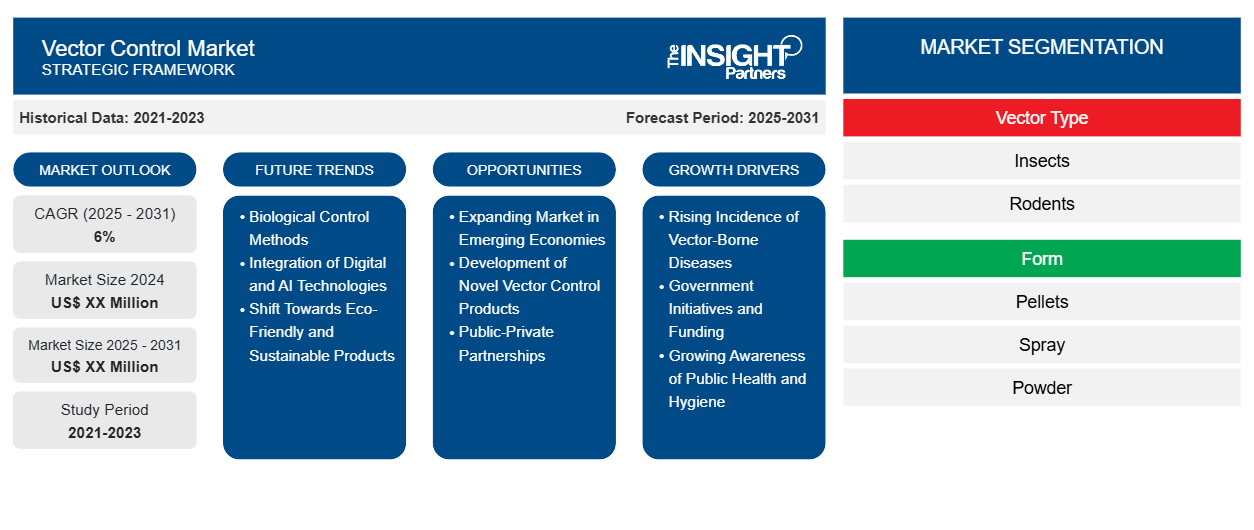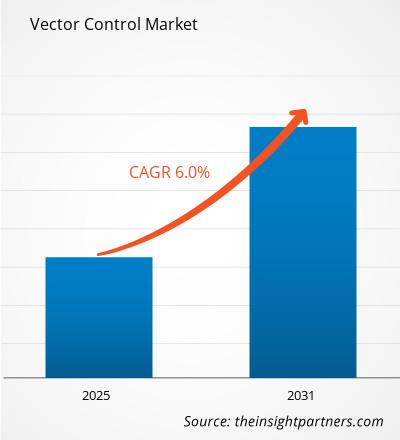The Vector Control Market is expected to register a CAGR of 6% from 2025 to 2031, with a market size expanding from US$ XX Million in 2024 to US$ XX Million by 2031.
The vector control market report is segmented by vector type (insects, rodents, and others). The market is segmented based on form (pellets, spray, and powder). The market is segmented based on technology (chemical, physical and mechanical, biological, and others). The market is segmented based on end use (residential, commercial, and industrial). The market size and forecast at global, regional, and country levels for all the key market segments are covered under the scope. The report offers the value in USD for the above analysis, segments, regions, and countries. The report covers market trends, as well as market dynamics such as drivers, restraints, and key opportunities. The report also covers industry landscape and competition analysis covering market concentration, heat map analysis, prominent players, and recent developments in the market.
Purpose of the Report
The report Vector Control Market by The Insight Partners aims to describe the present landscape and future growth, top driving factors, challenges, and opportunities. This will provide insights to various business stakeholders, such as:
- Technology Providers/Manufacturers: To understand the evolving market dynamics and know the potential growth opportunities, enabling them to make informed strategic decisions.
- Investors: To conduct a comprehensive trend analysis regarding the market growth rate, market financial projections, and opportunities that exist across the value chain.
- Regulatory bodies: To regulate policies and police activities in the market with the aim of minimizing abuse, preserving investor trust and confidence, and upholding the integrity and stability of the market.
Vector Control Market Segmentation
Vector Type
- Insects
- Rodents
Form
- Pellets
- Spray
- Powder
Technology
- Chemical
- Physical and Mechanical
- Biological
End Use
- Residential
- Commercial
- Industrial
You will get customization on any report - free of charge - including parts of this report, or country-level analysis, Excel Data pack, as well as avail great offers and discounts for start-ups & universities
Vector Control Market: Strategic Insights

- Get Top Key Market Trends of this report.This FREE sample will include data analysis, ranging from market trends to estimates and forecasts.
Vector Control Market Growth Drivers
- Rising Incidence of Vector-Borne Diseases: The increasing prevalence of vector-borne diseases, such as malaria, dengue, Zika virus, and Lyme disease, is a major driver for the global vector control market. These diseases, which are transmitted by mosquitoes, ticks, and other vectors, have a significant public health impact, particularly in tropical and subtropical regions. With climate change contributing to the expansion of vector habitats, the spread of diseases has become more widespread, heightening the demand for effective vector control measures. Governments, health organizations, and communities are increasingly investing in vector control programs to combat these diseases, driving the growth of the market.
- Government Initiatives and Funding: Government initiatives and increased funding for public health programs aimed at controlling vector populations are pivotal drivers for the vector control market. Many countries, especially in regions heavily affected by vector-borne diseases, have launched large-scale campaigns for the eradication or reduction of disease-carrying vectors. International organizations like the World Health Organization (WHO) and the Centers for Disease Control and Prevention (CDC) also provide substantial support for vector control programs. These investments in research, surveillance, and control methods create a robust market for vector control products and services.
- Growing Awareness of Public Health and Hygiene: Increasing awareness of the link between sanitation, public health, and vector-borne diseases is another key driver for the vector control market. As urbanization and population growth intensify, the need for vector control measures has become more urgent to prevent the spread of diseases in densely populated areas. Public education campaigns and the increasing importance of hygiene in preventing disease transmission are leading to greater adoption of vector control measures such as insecticides, repellents, and environmental management strategies. This heightened awareness is pushing demand for both preventive and curative vector control solutions.
Vector Control Market Future Trends
- Biological Control Methods: The use of biological control methods, such as the release of genetically modified organisms (GMOs), sterile insects, and natural predators (e.g., fish that consume mosquito larvae), is a growing trend in the vector control market. As resistance to chemical pesticides becomes a more significant concern, biological methods offer a more sustainable and environmentally friendly alternative. Companies and research organizations are focusing on innovative biological control solutions, including the release of genetically altered mosquitoes that are incapable of transmitting diseases like malaria and dengue. This trend is expected to gain momentum due to its long-term effectiveness and minimal environmental impact.
- Integration of Digital and AI Technologies: The integration of digital technologies, artificial intelligence (AI), and machine learning is revolutionizing the vector control market. AI-powered systems are being used to analyze data from mosquito traps, sensors, and environmental monitoring tools to predict and control vector populations more efficiently. Drones, GIS (Geographic Information System) mapping, and real-time surveillance are enabling better monitoring of vector habitats and the spread of diseases. This trend toward digitization will improve the targeting and effectiveness of vector control efforts while minimizing the use of harmful pesticides and reducing operational costs.
- Shift Towards Eco-Friendly and Sustainable Products: With growing concerns over the environmental and health impacts of chemical-based control methods, there is a noticeable shift towards eco-friendly and sustainable vector control solutions. Natural repellents, plant-based insecticides, and biocontrol agents are gaining popularity as alternatives to chemical pesticides. Consumers and governments are demanding more sustainable options that pose fewer risks to non-target species, including beneficial insects and ecosystems. This trend is pushing companies to innovate and develop environmentally safer vector control products, which will likely become a significant area of growth in the coming years.
Vector Control Market Opportunities
- Expanding Market in Emerging Economies: The vector control market presents significant growth opportunities in emerging economies, particularly in Africa, Asia-Pacific, and Latin America, where vector-borne diseases are prevalent. In these regions, governments and international organizations are increasingly focused on addressing the public health challenges posed by vectors like mosquitoes and ticks. Increased urbanization, higher population densities, and climate change further elevate the risk of disease outbreaks, driving the demand for effective vector control solutions. The expansion of healthcare infrastructure and the growing recognition of vector control's role in public health provide ample opportunities for market growth in these regions.
- Development of Novel Vector Control Products: As resistance to conventional insecticides grows, there is a growing opportunity for the development of new and innovative vector control products. Novel insecticides, biological agents, and genetically engineered mosquitoes present lucrative avenues for companies to invest in research and development. This could include the development of new chemical formulations with reduced toxicity to humans and the environment or the creation of new biological control methods that specifically target disease-carrying vectors. These innovations will drive the growth of the market, providing new opportunities for companies that can offer unique, effective solutions.
- Public-Private Partnerships: Public-private partnerships (PPPs) represent a significant opportunity for growth in the vector control market. Governments and private companies, especially those in the biotechnology, pharmaceutical, and environmental sectors, can collaborate to fund large-scale vector control projects, share research and development resources, and implement widespread control programs. These partnerships can help address the complex challenges of controlling vector populations while ensuring the availability of innovative and affordable products to combat vector-borne diseases. PPPs can also foster greater access to resources and funding in underdeveloped regions, contributing to better health outcomes and reducing the burden of disease.
Vector Control Market Regional Insights
The regional trends and factors influencing the Vector Control Market throughout the forecast period have been thoroughly explained by the analysts at The Insight Partners. This section also discusses Vector Control Market segments and geography across North America, Europe, Asia Pacific, Middle East and Africa, and South and Central America.
Vector Control Market Report Scope
| Report Attribute | Details |
|---|---|
| Market size in 2024 | US$ XX Million |
| Market Size by 2031 | US$ XX Million |
| Global CAGR (2025 - 2031) | 6% |
| Historical Data | 2021-2023 |
| Forecast period | 2025-2031 |
| Segments Covered |
By Vector Type
|
| Regions and Countries Covered | North America
|
| Market leaders and key company profiles |
|
Vector Control Market Players Density: Understanding Its Impact on Business Dynamics
The Vector Control Market is growing rapidly, driven by increasing end-user demand due to factors such as evolving consumer preferences, technological advancements, and greater awareness of the product's benefits. As demand rises, businesses are expanding their offerings, innovating to meet consumer needs, and capitalizing on emerging trends, which further fuels market growth.

- Get the Vector Control Market top key players overview
Key Selling Points
- Comprehensive Coverage: The report comprehensively covers the analysis of products, services, types, and end users of the Vector Control Market, providing a holistic landscape.
- Expert Analysis: The report is compiled based on the in-depth understanding of industry experts and analysts.
- Up-to-date Information: The report assures business relevance due to its coverage of recent information and data trends.
- Customization Options: This report can be customized to cater to specific client requirements and suit the business strategies aptly.
The research report on the Vector Control Market can, therefore, help spearhead the trail of decoding and understanding the industry scenario and growth prospects. Although there can be a few valid concerns, the overall benefits of this report tend to outweigh the disadvantages.
Frequently Asked Questions
What is the expected CAGR of the vector control market ?
What are the driving factors impacting the vector control market ?
What are the key players operating in the vector control market?
Which is the fastest growing segment based on vector type ?
Based on geography, which region held the largest share of the vector control market?
What is the future trend for vector control market?
- Historical Analysis (2 Years), Base Year, Forecast (7 Years) with CAGR
- PEST and SWOT Analysis
- Market Size Value / Volume - Global, Regional, Country
- Industry and Competitive Landscape
- Excel Dataset
Recent Reports
Testimonials
Reason to Buy
- Informed Decision-Making
- Understanding Market Dynamics
- Competitive Analysis
- Identifying Emerging Markets
- Customer Insights
- Market Forecasts
- Risk Mitigation
- Boosting Operational Efficiency
- Strategic Planning
- Investment Justification
- Tracking Industry Innovations
- Aligning with Regulatory Trends





















 Get Free Sample For
Get Free Sample For